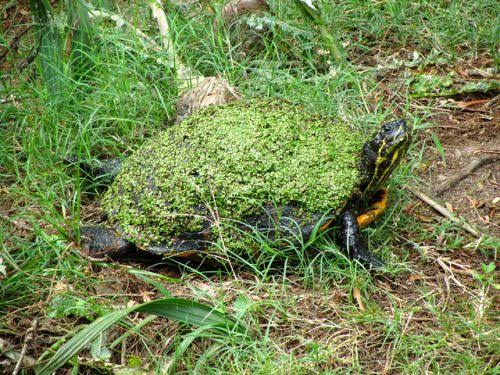
Camouflage is an incredible survival tactic used by animals to blend into their surroundings. Honed over millennia by dynamic environments and adaptable, constantly changing threats, it is as diverse as they come. However, the purpose is still pretty much the same across the board. Animals use camouflage to attract prey or protect themselves from predators – or both. What’s more? Some animals may possess more than one camouflage at once, making them even more remarkable at being elusive and very adaptable. In this article, we explore different types of camouflage and remarkable examples. Dig in!
What are the types of camouflage?
Broadly, camouflage can be classified into:
Background or Color matching
Disruptive coloration
Mimicry
Self-decoration
Cryptic behavior
Mimesis, and
Distraction Markings, among others.
The first three make up a large fraction of camouflage behaviors.
Background or Color Matching:

This involves the concealment of an organism from view by possessing a similar color to its surroundings and blending into it. This is easily one of the most common – and most remarkable – camouflage techniques in the wild, present in varying degrees in animals. For example, on the simpler end of the spectrum, animals such as squirrels possess fur with earthly hues, making it fairly easy for them to blend into the environment. Stonefish look exactly like stones, and when nestled in between them, they are easy to miss.

However, on the other (complex) end of the spectrum where chameleons and octopuses fall, the story is somewhat different. Why? For animals on the simpler end, it is easy to be spotted when they are yanked out from their niches and put in other unfamiliar ones. On the other hand, animals like chameleons are not held back by what the environment has to throw at them. They can keep up with the dynamism of the hues of nature by possessing the ability to adjust their colors on the go. Chameleons can change color by scattering or concentrating pigment granules in their cells. The more concentrated the granules, the lighter their colors, and vice-versa. This is an energy-sapping process. Nonetheless, it pays off in the long run because it is an indispensable, useful survival trait for them.

Somewhere in the middle of the spectrum, animals like the Artic Fox which changes colors based on seasonal changes are an honorable mention. Their furs are dark and light gray, charcoal brown, and bluish brown in the summer and pure white in the winter, making it easy to blend into the environment. Other mentions in this class of camouflage are nudibranchs (that derive their coloring from the food they eat, which helps in camouflage), flatfishes, and caterpillars.
Disruptive Coloration:


Disruptive coloration is a camouflage method in which the coloration of or the contrasting patterns of an animal breaks up its outline against the environment. This makes it difficult to discern the animal’s identity and location because of visual disruption. Honorable mentions of animals that utilize this form of camouflage include the leopard and the tiger. These two big cats owe a great deal of their hunting success to this ingenious survival tactic. Leopards, for example, use disruptive coloration to lay low in tree branches, where there are lots of shadows and contrasting spots of light. Their spotted furs help them blend in with the shadows and lighter areas of their surroundings.


Moreover, Zebras and Egyptian nightjars are other notable examples. At first glance, the stripes appear to be painfully obvious and counter-intuitive in terms of camouflage. But, here is how they work. When zebras gather in a herd, there are so many stripes and lines that their outlines break up against each other and it is difficult to make out each of them from the lot. Furthermore, when a zebra stands alone in the tall grass, the stripes cause them to blend in, ‘breaking’ its outline. And when there is a stampede, zebras all run in different directions in a pattern of white and black stripes that makes it easy for predators to lose them. The Egyptian nightjar uses its soft plumage and variegated coloring to camouflage itself in its surroundings which it tactically chooses and hides its outline against its background. They feed on insects such as crickets.
Mimicry:
This is a particularly interesting camouflage technique. Why? Because unlike others that involve being ‘unseen’, this method relies heavily on being ‘seen’ to work well. Mimicry is an adaptation that allows an organism to closely resemble another species (usually one with better survival skills). This boosts such organism’s chances of survival because predators are less likely to hunt them. It is a form of imitation. Some types of mimicry include Batesian, Mullerian, Wasmannian, and Peckhamian.

First, Batesian mimicry involves a non-poisonous, relatively harmless species taking on the looks and demeanor of a more poisonous, dangerous one. For example, the harmless king snake has evolved the same red, yellow, and black pattern as the venomous coral snake.

Mullerian mimicry is a phenomenon in which two or more species with effective defense mechanisms share a similar appearance or demeanor, causing a shared, potentiated repugnance from predators who would avoid them more actively than if they were ‘separate’. An example is similar-looking Monarchs and Viceroys (butterflies) being poisonous to wasps.

Peckhamian mimicry is a form of mimicry where predators or parasites mimic harmless animals to avoid being identified by their prey or host. An example would be a spider that looks and moves like its prey. These are wolves in sheep’s clothing. They creep in on their unsuspecting victims and kill them before they know what is happening.

Wasmannian mimicry is a phenomenon in which an animal resembles another species it lives with to blend in. It is commonly seen in insects. For example, beetles closely resemble ants. The ants can’t distinguish the beetles from other colony members and provide them with food, shelter, and protection.
Others…

Self-decoration: Animals use external materials, alive or dead, to cover their bodies. An example is the Eastern painted turtle which uses pond vegetation to camouflage itself while basking on a log, helping to avoid being preyed upon by birds of prey.

Mimesis: Animals mimic certain certain features in their environment (such as stones or dead leaves, for example) to go unnoticed.
Enjoyed this?
Check out other wildlife pieces here.



Leave a Reply